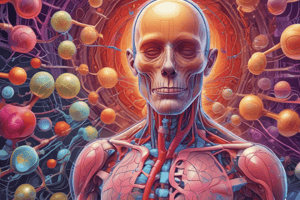Podcast
Questions and Answers
Where do nerves enter and the ureter exits in the kidney?
Where do nerves enter and the ureter exits in the kidney?
- Renal cortex
- Renal medulla
- Renal pelvis
- Hilum (correct)
What type of cells are present in the renal cortex, in addition to renal corpuscles and tubules?
What type of cells are present in the renal cortex, in addition to renal corpuscles and tubules?
- Fibroblasts and myofibroblasts
- Macrophages and fibroblasts (correct)
- Macrophages and adipose cells
- Fibroblasts and epithelial cells
What is the function of myofibroblasts in the kidney?
What is the function of myofibroblasts in the kidney?
- To filter blood
- To produce urine
- To resist volume and pressure (correct)
- To regulate blood pressure
What is the function of the renal pelvis?
What is the function of the renal pelvis?
What is the name of the space within Bowman's capsule?
What is the name of the space within Bowman's capsule?
What is the function of the glomerulus?
What is the function of the glomerulus?
What is the name of the structure that surrounds the glomerulus?
What is the name of the structure that surrounds the glomerulus?
What is the functional unit of the kidney that filters blood and forms urine?
What is the functional unit of the kidney that filters blood and forms urine?
What is the main function of the Proximal Convoluted Tubule (PCT)?
What is the main function of the Proximal Convoluted Tubule (PCT)?
What is the purpose of the Descending Limb of the Loop of Henle?
What is the purpose of the Descending Limb of the Loop of Henle?
Which hormone regulates sodium reabsorption in the Distal Convoluted Tubule (DCT)?
Which hormone regulates sodium reabsorption in the Distal Convoluted Tubule (DCT)?
What is the final segment of the renal tubule where the filtrate is collected from multiple nephrons?
What is the final segment of the renal tubule where the filtrate is collected from multiple nephrons?
What is the function of the Ascending Limb of the Loop of Henle?
What is the function of the Ascending Limb of the Loop of Henle?
Which hormone regulates water reabsorption in the Collecting Duct?
Which hormone regulates water reabsorption in the Collecting Duct?
Flashcards are hidden until you start studying
Study Notes
Kidney Structure
- The kidneys have a hilum, which is where nerves enter and the ureter exits.
- The kidneys are covered by a thin fibrous layer consisting of an outer layer of fibroblasts and collagen fibers, and an inner layer of myofibroblasts that resist volume and pressure.
Renal Pelvis and Calyces
- The upper end of the ureter expands and becomes the renal pelvis, which divides into 2-3 major calyces.
- The major calyces then turn into minor calyces.
- The area surrounding the renal pelvis and calyces has adipose tissue.
Kidney Parenchyma
- The kidney parenchyma is divided into renal cortex and renal medulla.
- The renal cortex is the outer, darker region containing renal corpuscles and tubules, as well as fibroblast-like cells and macrophages.
- The renal medulla is the inner region consisting mostly of aligned linear tubules and ducts, with myofibroblasts and 8-15 renal pyramids.
Renal Pyramids and Lobes
- Each renal pyramid has its base meeting at the cortex by the corticomedullary junction.
- Between each pyramid, there are areas called renal columns that separate the pyramids.
- Each pyramid and the cortical tissue at its side and base make a renal lobe.
Medullary Rays and Renal Lobules
- Parallel rays extending from the medulla into the cortex are called medullary rays.
- Medullary rays plus their cortical tissue are referred to as renal lobules.
Nephrons
- Nephrons are the functional units that filter blood and form urine.
- Each nephron consists of a renal corpuscle and a long renal tubule.
Renal Corpuscle
- The glomerulus is a tuft of capillaries where blood filtration begins.
- Blood enters the glomerulus through the afferent arteriole and exits via the efferent arteriole.
- Bowman's capsule is a double-walled capsule that surrounds the glomerulus and collects the filtrate from the blood.
Renal Tubule
- The renal tubule is a long, coiled tube divided into several segments, each with specific functions in processing the filtrate.
- The tubule segments include the proximal convoluted tubule (PCT), loop of Henle, distal convoluted tubule (DCT), and collecting duct.
Proximal Convoluted Tubule (PCT)
- The PCT is the first segment after Bowman's capsule, located in the cortex.
- The PCT reabsorbs a majority of the filtrate, including water, ions, and nutrients.
Loop of Henle
- The loop of Henle is a U-shaped structure with descending and ascending limbs that extend into the medulla.
- The descending limb is permeable to water but not to salts, allowing water to be reabsorbed into the medulla and concentrating the filtrate.
- The ascending limb is permeable to salts but not to water, allowing salts to be reabsorbed and diluting the filtrate.
Distal Convoluted Tubule (DCT)
- The DCT is the segment after the loop of Henle, located back in the cortex.
- The DCT continues to reabsorb ions and water, under the influence of hormones like aldosterone and parathyroid hormone.
Collecting Duct
- The collecting duct is the final segment that receives filtrate from multiple nephrons.
- The collecting duct reabsorbs water and concentrates the urine, regulated by antidiuretic hormone (ADH).
- The urine then flows into the minor calyx.
Studying That Suits You
Use AI to generate personalized quizzes and flashcards to suit your learning preferences.




